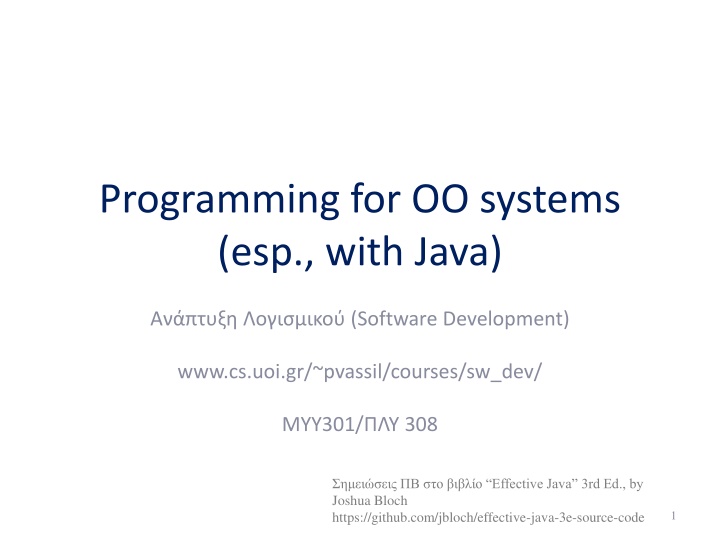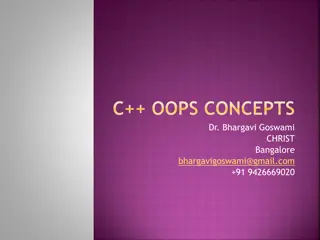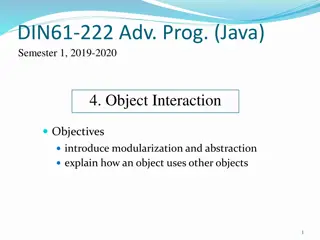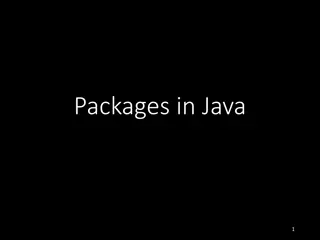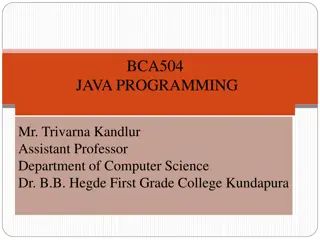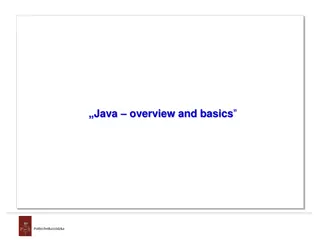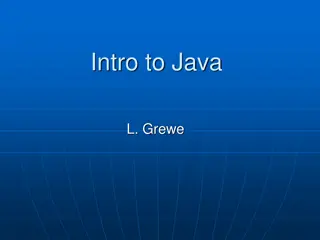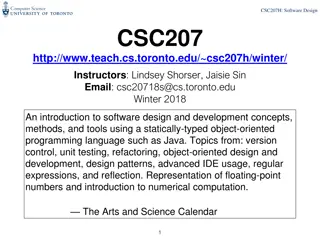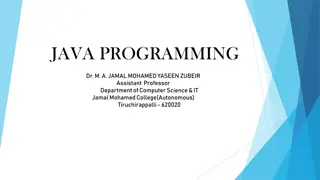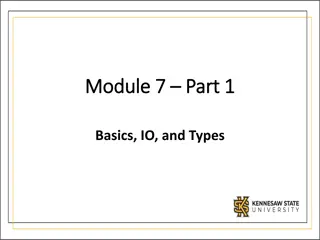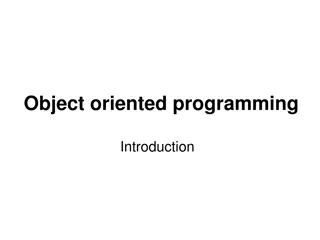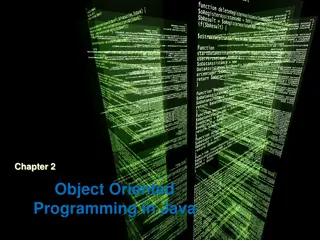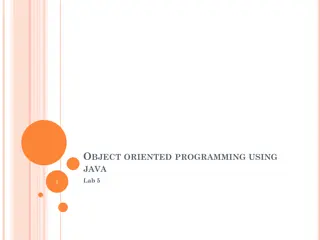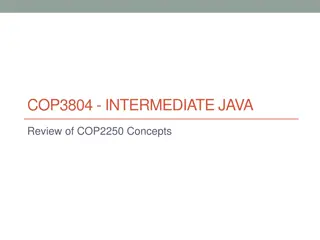Programming for Object-Oriented Systems with Java: Software Development
This resource provides valuable insights into programming for object-oriented systems using Java. The content covers Effective Java 3rd Edition by Joshua Bloch, offering a comprehensive guide for software development. Topics include best practices, design patterns, and principles for building robust and efficient Java applications. Whether you are a beginner or an experienced developer, this material is a must-read for honing your Java programming skills.
Download Presentation

Please find below an Image/Link to download the presentation.
The content on the website is provided AS IS for your information and personal use only. It may not be sold, licensed, or shared on other websites without obtaining consent from the author.If you encounter any issues during the download, it is possible that the publisher has removed the file from their server.
You are allowed to download the files provided on this website for personal or commercial use, subject to the condition that they are used lawfully. All files are the property of their respective owners.
The content on the website is provided AS IS for your information and personal use only. It may not be sold, licensed, or shared on other websites without obtaining consent from the author.
E N D
Presentation Transcript
Programming for OO systems (esp., with Java) (Software Development) www.cs.uoi.gr/~pvassil/courses/sw_dev/ MYY301/ 308 Effective Java 3rd Ed., by Joshua Bloch https://github.com/jbloch/effective-java-3e-source-code 1
Real world problem Requirements Engineering Design Requirements Specification Maintenance Design Specification Testing Implementation Working code with quality assurances Working code 2
/ Joshua Bloch, Effective Java (3rd ed., 2018) Java Effective Java textbook Java. textbook . , Java , developers . , pdf effective java 3rd edition , 3
9: 5
Java code conventions (#68) Construct Form. Syntax Essence Example mainengine, dataload package lowercase MainEngine, DataLoader Class CamelCase , IReporter, ISortedList Interface CamelCase ( ) interface (frequently starts with an I) getMonetarySum(), produceTotalEuroAm ount() method mixedCase ( ) . : ! receivedPackages, euroAmountSpent variable mixedCase ! _TOTAL_NUM_OWNERS CONSTANT UPPERCASE variable, , . _. construct where _ is allowed 6
(#68) Element order inside a java file package package xxx.xxx import import java.xxx ; import external.stuff.xxx; import from.this.prj.xxx; Package-private has no modifier; denoted via an empty space here /** class comments */ <visibility> class {public; ;protected;private} static {public; ;protected; private} <type><instanceVrbl class <ClassName ClassName>{ static <type><classVrbl instanceVrbl>; classVrbl>; <visibility>constructor <visibility>constructor constructor(){ } constructor( params ){ } {public/ /protected/private} doSth /* No particular order for methods: methods should be grouped by functionality rather than by scope or accessibility. The goal is to make reading and understanding the code easier. */ doSth( ){ } }//end class 7 https://www.oracle.com/technetwork/java/codeconventions-150003.pdf
Know thy libraries (#59) For Java, essential libraries: java.lang <-- Types/excep./errors java.io <-- Files java.util <-- Collections java.util.stream java.util.concurrent PV: repeatedly found very useful java.nio.file Apache commons Revisit with each new release ( )!!! Millions of users of standard libraries guarantee a much more debugged, safe, robust code than your own Do not re-invent the wheel; we stand on the shoulders of giants, not their foot toes! , . ! 8
Minimize the scope of local variables (#57) Declare a local variable where it is first used! almost always initialize it! Keep methods short & focused: minimizes the #vrbl s needed Postpone declaration until you know the initial value Special case: prefer for to while loops: easier to declare a variable inside the for loop (both (i) traditional for-loops and (ii) collection-related for (Element e: collection){ use e } Exception: variables to be used inside try/catch blocks 9
For-each is better than for (#58) BOTH for collections AND arrays: Use for (Element e : elements) { ... // Do something with e } .. instead of (the visual clutter of).. for (Iterator<Element> i = c.iterator(); i.hasNext(); ) { Element e = i.next(); // Do something with e If time: make a lengthier discussion && also cover exceptions } or for (int i = 0; i < a.length; i++) { // Do something with a[i] } Why? Because it allows the essential part of working with collections of similar items to be bluntly obvious to the reader: Iterate through the collection, by visiting one-item-at-a-time; Work with this single item you visit each time; And yes, arrays are yet-another case of collection-of-similar-items 10
If time: make a lengthier discussion for #61, #62 Data types: summary (#61) Prefer primitive types to boxed primitives (e.g., use int rather than Integer), wherever possible (#60) For monetary types, use int, long (18 decimal digits) or BigDecimal (albeit not primitive && slower) rather than float and double (both known with problems of precision)! (#62) Strings should NOT take the place of other data types/enum s/composite objects! : domain classes/enumerations/ , / string ! (#63) Contrary to what the 2018 book says, it is now perfectly OK to use String s = ; s += Extra stuff appended ; 11
Prefer Interfaces to Classes (#64) (#64) If it is possible to refer to an object via an interface, use the interface (which is a contract) to declare the object, rather than the concrete class Instead of (the concrete class) LinkedHashSet<Son> sonSet = new LinkedHashSet<>(); use (the interface) set<Son> sonSet = new LinkedHashSet<>(); Ideally (granted, this is not always possible): <Interface> vrbl = new <ConcreteClass>(); Why? Because it guarantees public methods && it is absolutely feasible to switch to another implementation if needed PV: which is the basic maintenance strategy for evolving maintaining our code too!! 12
(#25) Every file has a single top-level class and maybe some nested auxiliary classes too Always put top-level classes in a file that has exactly their name (e.g., class Person in file Person.java) The reasons are mainly, but not solely, due to the need that multiple persons cooperate in a team of developers under the principle of single location of the code, providing: 1. Understandability of the code by everyone 2. Easy location of code-of-interest by anyone, when in need, and 3. Avoidance of multiple definitions of the same construct, by different persons in different locations 14
Encapsulation is paramount (#15, #16) All that you make publicly available will be (ab)used by clients you do not control => Access to classes, methods and attributes should be given as sparingly as possible! - If the visibility of a class can be made package-private, make it so! - All attributes should be private; if possible, final too. This includes composite attributes too: e.g., all arrays should be private! - Simple FINAL_STATIC_CONSTANTS can be public; but not if they are collections (as they point to mutable objects). - All methods not publicly needed: private (in extremis: protected) or package-private for too cohesive packages 15
Why attribute encapsulation? Why all this fuss (and resulting language verbosity) with making fields private and accessing them via public methods? There is also the notion of consenting adults : we (are supposed to) know what we are doing with the classes that we use 16
Why attribute encapsulation? Typically, you prefer objects to be immutable! You do not want your clients to alter the state of your objects (not only in multithreaded environments, but overall). [GOOD PRACTICE] The gurus will tell you that typically, the only change in the state of an object should be done via a parameterized constructor. Later, if you want to change it, you want to consider the possibility of creating a new version. This means: NO SETTERS ALLOWED! 17
Why on earth no public attributes and no setter methods? Multiple composite objects can point to the same object: a change in the state of the object is not necessarily to be propagated to all of them (maybe some need a newer version, maybe some need the old one). 18
Ok, so we make the attribute private and we disallow setters. What about getters? Again: you make a class available, but you do not control who is gonna use it! The only way to control the usage is via a PUBLIC API OF METHODS Whatever you make public is a contract to clients: you are supposed to support it forever ; if you change it, the syntactic and semantic correctness of the code is in danger! 19
What about getters? So, you allow a method to be public only if you know that the method is providing a service to other parts of the software, outside the class where the method is defined! Exactly the same holds for classes and packages! You make a class public, i.e., you promise to support it forever , only if it is necessary for providing services to the rest of the system! 20
(#18) Prefer composition to inheritance Strongest possible coupling of two classes Not only all properties, but also all flaws of the parent are passed on to the child class A small change in the parent class can break the child class syntactically or semantically actually changes the child class too (i.e., a change in class C1 implies a change in class C2) In Java, specifically, a class can inherit only a single class (although it can implement several interfaces and be composed of several components) => if a class inherits a certain class, no further specialization can be via inheritance (e.g., if you want to implement a combination of {colored, non colored} X {rectangle, triangle, circle}, which is the mama class? ) 21
(#18) Prefer composition to inheritance All these problems are avoided if one uses composition Inheritance is NOT a friend; overriding is, for specific situations where you can have multiple, alternative implementations of a generic functionality, provided via components implementing the same interface Inheritance is appropriate in situations like the Template Method design pattern, where an abstract parent class implementing a sequence of steps can be customized in some of these steps In all other cases, make your class a composite class, delegate the work from the composite object to the methods of the appropriate component, and handle their result in the composite class: delegation via composition is the most appropriate method to handle complex tasks (see Decorator, Fa ade, design patterns) 22
(#18) Prefer composition to inheritance (mental checklist) To avoid: ALWAYS: Think HAS-A before IS-A! is a class declared final to prohibit subclasses? If (inheritance), check: the child IS-A mama in real-world? can we replace IS-A (inheritance) with HAS-A (composition)? Can we avoid protected at mama? If time: make a lengthier discussion for #19, not covered here 23
(#21) Design interfaces for posterity Interfaces are contracts An interface ServiceProvider specifies a behavior of its implementing classes, say Srvc1 and Srvc2, such that a client class, say Client, defines variables of type ServiceProvider in its code, and deal with Srvc1 or Srvc2, only at object creation. This means that if the implementors are updated, removed, or new implementors are introduced, the code dealing with the service is left untouched only object creation is affected 24
(#21) Design interfaces for posterity being contracts, to guarantee the provision of a service, means that interfaces change rarely, or else client code breaks! With interfaces You can extend them (but must retrofit implementor classes), or introduce new interfaces extending them You can complement them with new interfaces (as implementors can support multiple interfaces) But you cannot easily modify (even worse: delete) them, as both implementors and clients crash! 25
(#21) Design interfaces for posterity Always test introduced interfaces with multiple implementations, ideally from different developers, before introducing them! You cannot control your clients in OO! Once a code structure is made publicly available, its providers are bound to support it 26
(#20) Prefer Interfaces to Abstract Classes to define contracts of behavior Interfaces are more easy to manipulate when code changes: Existing classes can easily be retrofitted to fit an interface; much more difficult to fit an abstract class that passes structure to the child class Classes can implement multiple interfaces; abstract classes constrain the programmer to extend the code only via single-line inheritance Abstract classes are much better for Template Method cases, where structure and basic algorithm are predefined, and what is overridden is just steps of an algorithm 27
(#56) Write doc comments for all exposed API elements Precede every publicly exported class / interface / method / constructor / static field with a comment describing the contract between the provider and the client Methods (esp., at interfaces) are in the epicenter of this directive! You will need all: @param, @return, @throws, as well as preconditions and postconditions 29
(#51) Design methods carefully Choose names that are (a) understandable, (b) consistent with the dev community (e.g., toString() has specific implied semantics), (c) consistent with the project s conventions, and, (d) not too long Try to avoid too many or too few methods. Understandability of the class and the methods is important! Wherever possible, the types of the parameters should better be abstractions (ideally: interfaces) rather than concrete classes, wherever possible: Dependency Inversion Principle at work! Typical example: doSth(List aList) rather than doSth(ArrayList aList) Prefer enum s to Booleans (yes, I am guilty as hell) Try not to make long parameter lists can use helper classes to group parameter values [handle with care] 30
(#49) Check method parameters for validity All method parameters should be checked (PV: and tested) for validity. Yes, we are all bored to do it. But we must. Where to test for validity? Outside of the method, at the caller s site, before the method is called? First thing inside the method s src, before anything else happens? This becomes even more pressing when constructor methods are concerned . https://www.oracle.com/java/technologies/javase/seccodeguide.html 31
(#49) Check first thing inside the method and throw an exception Throw one of IllegalArgumentException, IndexOutOfBoundsException, NullPointerException Caller can catch it and now the method did not proceed Observe the check is the 1st thing done, BEFORE anything else https://stackoverflow.com/questions/45632920/why-should-one-use-objects-requirenonnull From the book observe the documentation too!! /** * Returns a BigInteger whose value is (this mod m). This method * differs from the remainder method in that it always returns a * non-negative BigInteger. * * @param m the modulus, which must be positive * @return this mod m * @throws ArithmeticException if m is less than or equal to 0 */ public BigInteger mod(BigInteger m) { if (m.signum() <= 0) throw new ArithmeticException("Modulus <= 0: " + m); ... // Do the computation } //Alternative for NullPointerException //Inline use of Java's null-checking facility this.strategy = Objects.requireNonNull(strategy, "strategy"); 32
(#49) Check first thing inside the method and throw an exception You need to keep the checks close to the method (ideally inside it), such that the method and its checks are together in the src Must make sure that illegal args do not harm the state of the system (e.g., system exit without closing streams, appropriate logging, ) Remember to document the @throws [PV] Constructors are a special case: due to their very specific nature, apart from the internal checks, one can always consider placing checks at factories, before the constructor is invoked. and, yes, they can throw exceptions too, to avoid object creation (but you must catch them at the invocation location, so as to react properly to what happens if the object is not constructed) https://stackoverflow.com/questions/30803650/java-how-to-only-create- an-object-with-valid-attributes https://stackoverflow.com/questions/1371369/can-constructors-throw- exceptions-in-java?noredirect=1&lq=1 33
(#52) If possible avoid overloading Overloading = same method name with different arguments inside the same class Overriding = identical methods at different classes overriding mama/interface method Avoid overloading via different names If not possible, use method signatures with different numbers of parameters If not possible, use signatures where you cannot pass the same parameter via casts If not possible, ensure they produce identical behavior But basically, avoid it 34
(#54) Return empty collections instead of nulls .. to avoid having to check for null To avoid paying the price for allocating new empty collections you can invoke sth like return Collections.emptyList(); or similarly. 35
CHAPTER 9 CHAPTER 4 CHAPTER 8 (#68) Stick to language conventions: (a) naming + (b) ordering within a file (#25) Every file: a single top-level class (#56) Write doc comments for all publicly exposed API elements (#15, #16) Enforce encapsulation (#57) Minimize the scope of local variables + declare/[init] a local variable at its first use (#51) Design methods carefully! If the visibility of a class can be made package private, make it so! Choose names that are (a) understandable, (b) consistent with the dev community & project s conventions, and, (d) not too long (#57)(#58) All iterators (even for arrays(!)): All methods not publicly needed: private or package-private for too cohesive packages for(Elemente:elements){workwithe} Choose a useful return type (PV)!! (#61) Prefer primitive types to boxed primitives (e.g., intto Integer) All attributes should be private; if possible final too. This includes composite attributes too: e.g., all arrays should be private! Avoid too many/few methods in a class (#60) For monetary types, use int, long, or BigDecimal ; avoid float &double! Wherever possible, parameter types should be abstractions (ideally: interfaces) Simple FINAL_STATIC_CONSTANTS can be public; but not if they are collections (#62) Strings should NOT take the place of other data types / enum s / composite objects! (use enum) Prefer enum s to Booleans (#17) If possible, enforce immutability Try not to make long parameter lists can use helper classes to group parameters No setters, just parameterized constructors (#64) If it is possible declare an object via an interface (#49) Check parameters for validity Methods (e.g., getters) return defensive copies of attributes, esp. if collections first thing inside the method s body <Interface>vrbl=new<ConcreteClass>(); (#18) Prefer composition to inheritance! throw appropriate exceptions (typically NullPointer, IllegalArgument) ALWAYS: Think HAS-A before IS-A! Classes declared final (no subclasses) (PV) For constructors: throwing an exception annules the object construction; the factory can do it too, externally. If (inheritance), check: (a) the child IS-A mama in real-world? (b) can we replace IS-A with HAS-A? (c) can we avoid protected at mama? Make sure exceptions do not destroy object state (use defensive copies) or common resources (e.g., IO streams) (#20, #21) Prefer Interfaces to abstract classes to define contracts of behavior Document @throws & explain why s & when s design Interfaces for posterity (#52) Avoid overloading Use abs. classes for Template Method (#54) Return empty collections instead of null s Short checklist, Effective Java 3rd Ed., by Joshua Bloch
